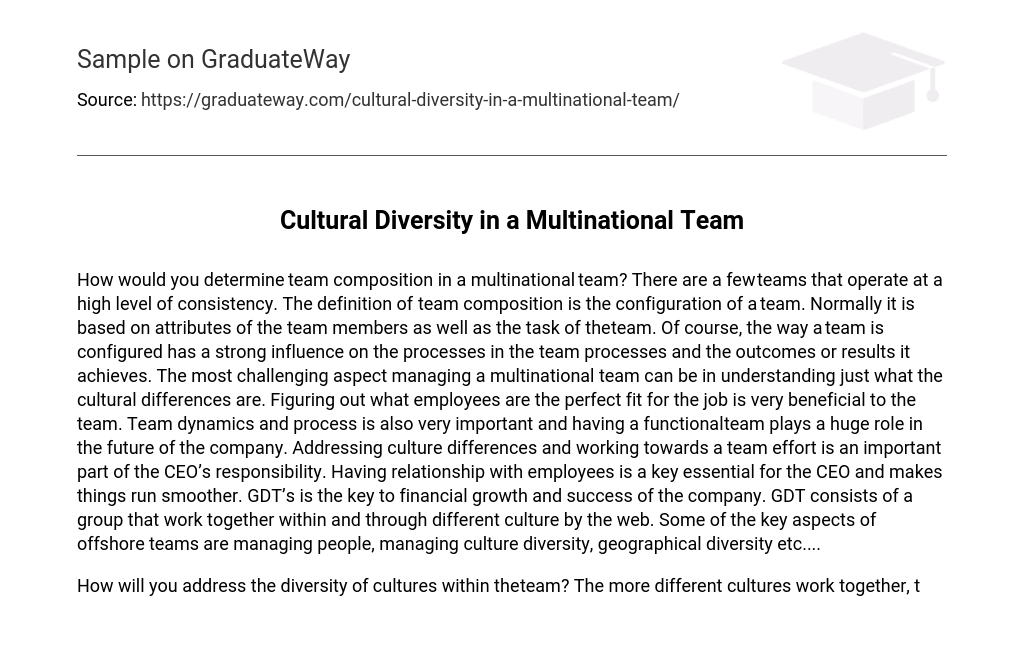How would you determine team composition in a multinational team? There are a few teams that operate at a high level of consistency. The definition of team composition is the configuration of a team. Normally it is based on attributes of the team members as well as the task of the team. Of course, the way a team is configured has a strong influence on the processes in the team processes and the outcomes or results it achieves. The most challenging aspect managing a multinational team can be in understanding just what the cultural differences are. Figuring out what employees are the perfect fit for the job is very beneficial to the team. Team dynamics and process is also very important and having a functional team plays a huge role in the future of the company. Addressing culture differences and working towards a team effort is an important part of the CEO’s responsibility. Having relationship with employees is a key essential for the CEO and makes things run smoother. GDT’s is the key to financial growth and success of the company. GDT consists of a group that work together within and through different culture by the web. Some of the key aspects of offshore teams are managing people, managing culture diversity, geographical diversity etc….
How will you address the diversity of cultures within the team? The more different cultures work together, the more cultural competency training is essential to avoid problems. Cultural problems can range from miscommunication to actual conflict, all endangering effective worker productivity and performance. Communication: Providing information accurately and promptly is critical to effective work and team performance. Team building: Some cultures – like the United States – are individualistic, and people want to go it alone. Other cultures value cooperation within or among other teams. Time: Cultures differ in how they view time. For example, they differ in the balance between work and family life, and the workplace mix between work and social behavior. Schedules: Work can be impact by cultural and religious events. The business world generally runs on the western secular year, beginning with January 1 and ending with December 31. But some cultures use wildly different calendars to determine New Year’s or specific holy days. For example, Eastern Orthodox Christians celebrate Christmas on a different day from western Christians. For Muslims, Friday is a day for prayer. Jews observe holidays ranging from Rosh Hashanah to Yom Kippur (n.d).
Because the team will operate in a virtual existence, what structure and support will this team need to foster productivity? A variety of factors led to the rise of virtual teams. Increasingly sophisticated technology made it possible, and globalization made it necessary. Once virtual teams began, organizations noticed an unanticipated bonus: increased productivity. According to Chad Thompson, senior consultant with Aon Hewitt, the productivity of effective virtual teams can increase from 10 to 43 percent, depending on the industry and the organization, and in several cases, the increase in productivity was equal to (or more than) the organizations’ savings on real estate costs. In addition, studies confirm that virtual teams offer employers and employees flexibility, reduce time to market, often result in better work outcomes than conventional work teams, attract better talent, and increase knowledge sharing. Global virtual teams allow organizations to garner talent from all parts of the world, save money on travel, and allow access to lower-wage resources. (Lockwood, N. (2010). Successfully Transitioning to a Virtual Organization: Challenges, Impact, and Technology, SHRM Research Quarterly. Alexandria, VA.). Participating in the selection process of virtual team members and leaders’ Successful virtual employees are self-motivated and self-reliant, excellent communicators, and able to work independently but not “lone wolves.” HR and talent management professionals can assist virtual team leaders at the team formation stage by assessing whether employees possess these skills to operate within a virtual team or can develop them with additional training. Training is very important for virtual teams to succeed.
How will you measure the success of the team? First, you must establish a bottom line. This should be the level that you expect your team to operate at, if nothing changes. Setting a quantifiable and measurable goal allows your analysis to be more precise. It also allows you to hold your team accountable since they have something specific to work toward. Seeing the progress of competitors allows us to gauge their own speed, gain motivation, and consider strategies to stay ahead. Taking the time to determine if a certain person is bringing down or raising up the team is a good habit to get into. you must not forget to evaluate yourself as a manager.
What are the characteristics you will look for in a leader of this team? I will look for clear communicator, strong organization skills as this is important in a company. I will always also be looking for confidence in the team and respectful. Someone who can work under pressure would be a great characteristic to possess.
References
- Managing Cultural Diversity in the Workplace. (n.d.). Retrieved January 22, 2020, from https://www.diversityresources.com/cultural-diversity-workplace/
- Freifeld, L. (2013, October 22). 3 Steps to Support Virtual Teams. Retrieved January 22, 2020, from https://trainingmag.com/content/3-steps-support-virtual-teams
- Taylor, T. A. (2018, June 14). Diversity, Inclusion and Culture: How to Build Great Teams. Retrieved January 22, 2020, from https://open.nytimes.com/diversity-inclusion-and-culture-steps-for-building-great-teams-ca157bd98c07





